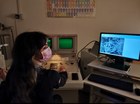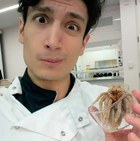Theses Archive
Bachelor's and Master's degree from 2014 to 2024
Biosignatures and preservation potential in metalliferous mineralizations (Capoliveri, Elba Island)
Mattia PALADINI, Bachelor student in Natural Sciences
His interests are Astrobiology and the habitability of referenced planets or extreme environments as well as biosignatures in extreme environments. Currently he is involved in a research on "Biosignatures and preservation potential in metalliferous mineralizations (Capoliveri, Elba Island).
The effect of Martian analogue minerals on the survival of bacteria with focus on ferroptosis
Miriam LANUTI, Master's student in Biodiversity and Evolution
Studies the effect of Martian analogue minerals on the survival of bacteria with a focus on ferroptosis. How microbial model organisms such as Deinococcus radiodurans and E.coli respond to eroded minerals with relevance for Martian regolith composition and with different fractions of iron. The focus will be on achieving an understanding of the types of damage that er inflicted on the cells due to Fenton-type reactions and the reactive oxygen species (ROS) that are produced due to these reactions. Cell survival will be evaluated both by CFU counts and by plade-reader-based Baclight enumeration of Dead and Life cells.

The effect of UVC-irradiated iron minerals present on mars on the survival of Deinococcus radiodurans
Filippo Cuoghi COSTANTINI, Master's Degree in Geology and Territory
ABSTRACT: The habitability of Mars is determined by the physical and chemical factors that characterise the planet's atmosphere and soil. Low atmospheric pressure, amount of water, temperature and strong UV radiation are highly studied factors in relation to the survival of microorganisms. These represent minor challenges for extremely resistant bacteria such as Deinococcus radiodurans, which particularly suffer from oxidative stresses due to the high presence of iron oxides in the soil leading to the formation of reactive oxygen species (ROS). In this study, we investigated the stress effect induced by iron oxides such as hematite, magnetite and maghemite under anaerobic conditions by examining the survival of the model microorganism Deinococcus radiodurans. In addition, we analysed the effect of glutathione in cells subjected to iron excess stress and the role of ferroptosis in cell death. We found that iron oxides negatively affect the survival of bacteria. Exposure to hematite killed more than 99% of the cells, while magnetite and maghemite were found to be less toxic. We propose that the cause of the stress effect of iron oxides is caused by the production of reactive oxygen species through the Fenton reaction due to excess iron. The production of hydroxyl and hydroperoxyl radicals leads to the iron-induced process of lipid peroxidation known as ferroptosis. We also found that glutathione at low concentrations inhibits the detrimental effects of hematite, while at high concentrations it is toxic to cells. We assume here that glutathione can reduce reactive oxygen species as observed in eukaryotic cells. More in-depth studies on the role of ferroptosis in bacteria must be conducted in the future.
Supervisor Prof. Barbara Cavalazzi; Co-supervisor: Prof. Kai Finster.
Completed: March, 2023.

Eocene benthic macroforaminifera communities present in the Udine area
Filippo Cuoghi COSTANTINI, Magistrale in Geologia e territorio
Completed: 2023
New hypotheses on the structure of Eiphelian tube worms from the Hollard Mound, Morocco
Simone SUBACCHI, Master's student in Biodiversity and Evolution
ABSTRACT: In recent decades, particular attention has been paid to deep habitats fed by hydrocarbon-rich fluids, called cold seeps, which typically host (endemic) communities of brachiopods, molluscs and tube worms and are characterized by a high abundance of oligotypical. We present here the results of a detailed study carried out with the use of different analytical techniques of tube-like structures of the Devonian (Eiphelian) of the Paleoseep Hollard Mound (Ant Atlas, Morocco), which have been interpreted as vestimentiferous and which could, in this case, represent the most ancient fossil record in seep environment. The combination of analytical techniques such as optical microscopy, confocal laser scanning microscopy (CLSM), Raman microspectroscopy and scanning electron microscopy with X-ray microanalysis (SEM-EDX), applied on the tubular fossil remains of the Hollard Mound, has been used at the purpose to declare some aspects regarding their origin. The results allow to appreciate the specific ultrastructures of these tubes and to define in situ their chemical-mineralogical composition at the sub-micrometric scale.

Microbial activity associated to the microterracettes situated in the hydrothermal sistem of Eyvindarhver, Hveravellir (Iceland)
Alice TAROZZI, Bachelor degree in Biological Sciences
ABSTRACT: The thesis focuses on the microbial activity associated to the microterracettes situated in the hydrothermal sistem of Eyvindarhver, in the hydrothermal area of Hveravellir (Iceland) and their astrobiological implications. It was based on some samples prof. Barbara Cavalazzi storaged in situ back in 2018, we studied and took many images of some samples on both optic and electronic microscope, to search for some biosignatures and compare them to the ones already collected in other astrobiological papers.
Completed: December 2021
Survival analysis of the black fungus Cryomyces antarcticus exposed to simulated martian conditions and space relevant radiation
Elisa LOGIUDICE, Master's degree in Geology and Territory
ABSTRACT: The extreme environmental conditions experienced on Mars surface, including radiation and the perchlorate species, could represent a challenge for life as we know it. To understand how life cope to these conditions, astrobiological studies are based on the investigation of the survival limits of terrestrial extremophiles. In this context, the black fungus Cryomyces antarcticus, isolated from McMurdo Dry Valleys (Southern Victoria land, Antarctica), is considered as a good test organism, due to its high resistance against different stressors. In mythesis work we tested the resistance of the fungus in different conditions: i) grown on MEA medium with perchlorates, such as Mg(ClO4)2 and Ca(ClO4)2, and exposed to simulated Martian conditions inside a MSF with day-night cycles for 24 hours, 4 and 7 days, not irradiated (Dark) and irradiated (UV and UV+LED radiation); and ii) i cultivated in 1.5% MEA culture medium and exposed, hydrated and de-hydrated, to acute and chronic ɣ rays at different doses (27 and 56 kGy) within Calliope Facility. The responses of C. antarcticus after the exposure of the two treatments were evaluated investigating different aspects: the growth ability, the metabolic activity, recovery, and the DNA damage. In general, the results indicated that this organism in de-hydrated conditions, is able to survive and maintain its DNA integrity on after exposure to a similar Martian surface environment, in presence of perchlorate, for at least 7 days exposed to UV+LED radiation. In addition, the integrity of DNA and a good metabolic activity recovery was reported after the exposure to chronic ɣ ray irradiation at 27 kGy, both in hydrated and de-hydrated state, even if no survival was recorded.
SUPERVISOR: Prof. Barbara Cavalazzi, Univ. Bologna; CO-SUPERVISOR: Prof. Silvano Onofri, Università della Tuscia.
Completed: December 16, 2021

The application of FTIR micro-spectroscopy to the study of Paleoarchaean microbial mats and its implications for astrobiological research
Giacinto De VIVO, Master's degree in Biodiversity and Evolution
ABSTRACT: Palaeobiological research on Archaean fossiliferous horizons is key to understanding the early evolution of life and important as a test case for the search for life on other planets. Herein, we use FTIR spectroscopy, a powerful tool for identifying functional groups in or-ganic compounds by analysing changes in their vibrational motion, to detect and study Pale-oarchean biosignatures by producing IR maps. Of particular relevance is the ratio between the aliphatic methyl and methylene stretch (the R3/2 ratio), which is thought to reflect the nature of the membrane lipids of the original organisms and thus represent a potential tax-onomical signature: archaea possess methyl branch-rich isoprenoid chains whereas bacte-ria comprise simple chain fatty acids. We used IR mapping to analyse six 3.48 Ga old rock samples collected during the Barberton drilling project in the Buck Reef Chert BARB3 core (Barberton greenstone belt, South Africa) and rich in carbonaceous material have been an-alysed. Microbial mats in these horizons represent one of the oldest robust lines of evidence for life. Our results show higher R3/2 values (~0.50) in the oldest and the youngest sample, an indication of a mixed archaea and bacteria ecosystem, and lower values (~0.20) in all the others, suggesting a bacteria-dominated ecosystem. These differences might reflect a palaeoecological transition associated with a gradual shift from an evaporitic to a platform and finally basin palaeodepositional environment. The quality and number of data collected demonstrate that micro-FTIR mapping is a powerful non-invasive technique to detect and study autogenous organic material and has a strong potential in astrobiological research. Hence, we encourage its use in the study of possible biosignatures during the analysis of samples of astrobiological interests, for example, those collected by the upcoming Mars Sample Return missions.
SUPERVISOR: Prof. Barbara Cavalazzi, Univ. Bologna; CO-SUPERVISOR: Dr. K. Hickman-Lewis, Natural History Museum, UK.
Completed: May 28, 2021

Analysis of the DNA damage of the black fungus Cryomyces antarcticus after exposure to increasing doses of γ-rays
Rebecca MARTELLOTTI, Bachelor degree in Biological Sciences
ABSTRACT. The mystery regarding the origin of life and its uniqueness in the universe has pushed the scientific world in recent years towards a new field of research, astrobiology. This interdisciplinary science includes research on the origin and evolution of planetary systems, the origin of organic compounds in space, the search for biological signatures for the detection of life, and research on the adaptation and limitations of life as we know it, with a particular focus on the study of extreme environments and related extremophiles to be able to make hypotheses about life outside our planet and how to search for it. One of the target environments is the Dry Valleys of McMurdo in Antarctica as they are considered an excellent analog of Mars, a planet at the center of attention of space agencies due to its primordial environment extremely similar to that of Earth. The extremophile organisms that inhabit these environments have adapted to the most surprising conditions; among these, the Antarctic cryptoendolytic black fungus Cryomyces antarcticus CCFEE 515, isolated from the McMurdo Dry Valleys, is one of the most resistant eukaryotic microorganisms known so far. Given its extraordinary ability to survive Mars-like extreme conditions, it is considered one of the best candidates for astrobiological studies aimed at testing its survival and consequently the potential habitability of the red planet. There are several factors that can limit life, but certainly one of those that most hinders the survival of microorganisms outside the Earth is ionizing radiation, of which γ rays are a part. In the present thesis work and within the project "Life in Space - Origin, Presence and Persistence of Life in space: from molecules to extremophiles financed by ASI, hydrated colonies of the fungus C. antarcticus were exposed to increasing doses of γ (27, 56 and 117 kGy), in order to evaluate the presence of DNA damage. The data obtained from qualitative analyzes using the PCR technique and quantitative analyzes using the quantitative PCR technique, showed DNA damage only on different sections of the genome, even at the lowest irradiation dose (27 kGy). These preliminary data provide valuable support for future space exploration missions.
SUPERVISORS: Prof. B. Cavalazzi, Univ. Bologna; Prof. S. Onofri, University of Tuscia
THESIS completed on March 11, 2021
Martian analogues - Multianalytical approach and implications for in situ Martian exploration
Alfonso Valerio RAGAZZO, Master's degree in Biodiversity and Evolution
ABSTRACT: Questa tesi propone un approccio multianalitico per lo studio di campioni analoghi marziani di interesse astrobiologico e geologico planetario. Tra le varie tecniche analitiche utilizzate, i campioni selezionati sono misurati con il modello di laboratorio dello spettrometro miniaturizzato Ma_MISS (Mars Multispectral Imager for Subsurface Studies), installato all’interno del trapano a bordo del rover R. Franklin, della prossima missione ExoMars, che ha come obiettivo principale la ricerca di tracce di vita (passata o presente) sulla superficie di Marte. L'analisi spettrale, finalizzata allo studio della mineralogia di campioni geologici, costituisce un fattore di indagine importante ai fini della ricerca nel campo delle scienze planetarie. I due campioni naturali oggetto di questo studio hanno una origine legata a fenomeni di idrotermalismo e possono essere considerati analoghi di Marte per la loro composizione chimica e per i processi geologici che sembrano essere gli stessi ricostruiti per Oxia Planum (Marte), ovvero il sito di atterraggio scelto per la ExoMars rover mission. In particolare, in questa tesi verranno studiate le relazioni tra le facies mineralogiche, i potenziali pattern di fossilizzazione e le firme spettrali di 1) un campione di silice proveniente da una sorgente idrotermale (attiva) del campo geotermico di Hveravellir in Islanda, e 2) di due campioni di argilla pedogenetica, appartenenti allo stesso profilo pedologico, che presentano alterazioni di tipo idrotermale (legate alla risalita di fluidi idrotermali) seguite da processi pedogenetici di lisciviazione del suolo. In relazione a ciò, è stato dimostrato che i campioni scelti per questa tesi sono degli ottimi analoghi marziani, essendo in possesso di caratteristiche spettrali, quindi chimico-fisiche, riconducibili ai depositi individuati su Oxia Planum (Marte).
SUPERVISOR: Prof. Barbara Cavalazzi, Univ. Bologna; CO-SUPERVISOR: Dr. Marco FERRARI, INAF, Roma.
Completed: May 23, 2022

Geomicrobiological characterization of pisoids from the Eyvindarhver hydrothermal vent (Hveravellir, Iceland) and their astrobiological implications
Daniele PETRUCCI, Master's degree in Geology and Territory
ABSTRACT: This study is focused on the analysis of particular sedimentary structures of spherical or sub-spherical shape (with diameter greater than 2 mm) present in different terrestrial natural environments. These spherical structures, spherules, are typically due to the precipitation of calcite in a subaerial environment which can occur both by oscillation of the water table within an unconsolidated sediment, and by direct precipitation of calcite by desiccation in ephemeral pools. However, spherules of different nature and composition are known in the geological record: 1) pisoids of low-magnesium calcite, of oxides and/or hydroxides of iron, of silica (quartz or opal), are known, for example, 2) they are associated with environments very different from each other from shallow to deep marine, vedose environments and high and low temperature hydrothermal environments, and 3) their genesis can be linked to completely inorganic precipitation (allochemical product), they can be biologically induced products (bio-mineralizations) , or due to an alternation between the two processes just mentioned. For this reason and for their high preservation potential in the geological record, pisoids are considered important environmental and palaeoenvironmental indicators, but also in specific cases as biosignatures. Recently, some hematite (iron oxide) spherules, better known as blueberries, were identified on the surface of Mars in the Meridiani Planum by the NASA Opportunity rover. By analogy with terrestrial spherules, hematite blueberries would seem to indicate that they were formed on Mars in the presence of water, i.e. they would appear to have formed as concretions formed by precipitation of saturated aqueous fluids.
The aim of this degree thesis was to characterize some siliceous pisoids from the Eyvindarhver site of the Hveravellir geothermal system in Iceland, to define their mineralogical composition and biological component, and clarify their mutual relationships. For this purpose, the samples were prepared in thin sections and studied under an optical microscope and a scanning electron microscope equipped with an EDX energy detector (SEM-EDX). The thesis is divided into five chapters: 1) an introduction illustrating the different types of terrestrial spherical structures and their formation environments; 2) the materials and methods used to carry out the analytical part of this study; 3) the results obtained are illustrated and discussed critically and interpreted on the basis of analogous structures described in the literature, and seem to indicate a mixed genesis, i.e. due to microbial mediation (different microbial morphologies have been recognised) alternating with inorganic precipitation of silica around to volcanic lithoclasts; 4) the potential astrobiological implications, in fact, the Eyvindarhver spherules can be used as terrestrial analogues for the search for life on other planets; 5) in conclusion, it is recognized that studies of terrestrial analogues, such as that of Eyvindarhver's pisoids, which suggest an at least partly biological genesis, are fundamental for understanding how to identify astrobiological samples in future space missions such as Mars2020 and ExoMars2022.
SUPERVISOR: Prof. Barbara Cavalazzi
Thesis discussed: July 2020
Geomicrobiological characterization of the water column and sediments of Río Tinto (Huelva, Southwestern Spain)
Silvia ALVISI, Laurea Triennale in Biologia
The field of her thesis research is related to Astrobiology, in particular is about the geomicrobiological characterization of the water column and sediments of Río Tinto (Huelva, Southwestern Spain). The extreme acidic conditions of Río Tinto basin are the consequence of an active underground bioreactor that obtains its energy from the massive sulfidic minerals existing in the Iberian Pyrite Belt.The similarities between the vast sulfate and iron oxide deposits on Mars and the main sulfide bioleaching products found in the Tinto basin, have given Río Tinto the status of a geochemical and mineralogical Mars terrestrial analogue.
Supervisori: Prof. Barbara Cavalazzi, UNIBO; Prof. Felipe Gomez, Centro de Astrobiología, Madrid, Spain.